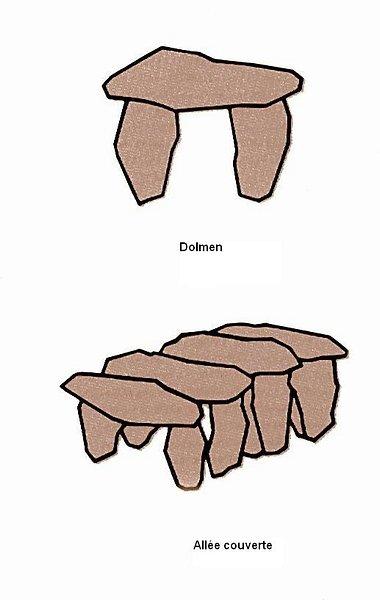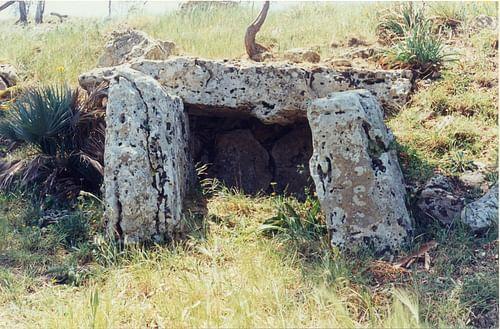A dolmen is a megalithic structure typically formed from a large horizontal stone slab resting on two or more upright slabs. The oldest European examples are found in Brittany, northern France, and date to the 5th millennium BCE. Dolmens are also present in the Middle East, North Africa, Asia, and especially large numbers exist in Korea, with examples there dating to c. 1000 BCE. The structures functioned as burial chambers or as sites of ancient cult worship, for example to an earth or fertility goddess.
Naming
Megalithic architecture, specifically the construction of sanctuaries and tombs using enormous blocks of stone, occupies an important position in the cultural experience of Prehistory. The word dolmen, which derives from Breton t(d)aol meaning table and men or min meaning stone, appears in the scientific debate around the end of the 1700s CE. Until that time the examination of these “strange” monuments, scattered here and there, gave way to suppositions that were, to say the least, fanciful. It was thought they were works built by giants or, indeed, deeds of the devil. The first investigations were, therefore, to understand the use of these structures and establish their age, even though the absence of metal objects indicated the period they could belong to.
Preliminary Investigations
In the second half of the 1800s CE, the publication of the first European map of the known megalithic localities highlighted so many coincidences that it led to the belief that they were the work of one unique population. Therefore it seemed justifiable to consider the “megalithic phenomena” an unusual cultural manifestation of the Near East and dolmens, in definition, the unnatural reproduction of the Mediterranean burial grotto.

The Australian archaeologist V. Gordon Childe reinforced this hypothesis in his last book The Prehistory of European Society where he claimed that the construction of the enormous mausoleums was carried out by mythical megalithic missionaries, members of some early Aegean tribes from the eastern Mediterranean, who divulged a religious faith known to belong to the cults of Gaia the Mother Goddess, goddess of the earth.
Dating
The perfection of absolute dating systems, thanks to the 14C radio-carbon method, put an end to this thesis once and for all. It was proven that the oldest megalithic tombs originated in central/northern Europe. Breton dolmens date back to 4500 BCE (earlier, therefore, than the Egyptian pyramids, Mesopotamian ziggurats and the great Cretan and Mycenae sites). They spread further south to central and southern France, south-west to Spain and Portugal and north-east to the central lowlands of Europe, Sweden and so on. They concluded their phase with the most recent constructions in Malta, around 2400 BE and in Italy at the beginning of the 2nd millennium BCE.
The above time range was sufficient for each region to evolve a local typology though keeping a common characteristic: the use of blocks or slabs of stone, at times colossal in dimension, which made them phenomena tied to a fairly widespread culture.
The Mediterranean dolmens are to be dated back to an era closer to ours. Around 100 can be found throughout Sardinia, some of which, the so-called dolmen cysts made up of stone slabs assembled in a cubiform manner, are dated back to the Copper Age, around 3000-2100 BCE. Dolmens in southern Italy, which are more recent, date back to the first half of the 2nd millennium BCE, the period corresponding to the latter phase of the Bronze Age.

Outside of Europe, the most frequent occurrence of dolmens is in the Korean peninsula where there are some 200,000 megalithic structures. Korean dolmens are remarkably similar to those found in Europe. Finds excavated from within many of the dolmens illustrate that they were typically used for elite burials. Unusually, Korean dolmens were sometimes built in close proximity to each other, creating cemetery-like areas consisting of between 30 and 100 structures.
Principal Characteristics
The most elementary configuration of the dolmen is trilithic: a horizontal slab of stone placed on top of two vertically positioned stones in order to form a construction where the structural elements frame a quadrangular space. Such forms can be found just about anywhere, in Iceland, Scotland, England, North Germany, France, Spain, Scandinavia, Denmark, Holland, Corsica, Sardinia, Apulia, Sicily, Malta, North Africa, Morocco, Tripoli, Egypt, Syria, Palestine, Bulgaria, Crimea, Caucasus, Iran, India, Korea.
More complex forms which were made up of a long or even longer succession of triliths followed, so generating two particular types: the corridor tomb and the gallery tomb (allée couverte). The corridor tombs, made of big slabs of stone vertically fixed into the ground (orthostats), have corridors that vary in length and lead to a chamber or a number of chambers of a polygonal shape. The gallery tombs, instead, have just one rectangular-shaped space used entirely as a sepulchral chamber.

Some of these structures evolved into rather complicated constructions, as in the case of the false dome dolmens where the convex roof was obtained by gradually decreasing the distance between the slabs of the building. Another instance is that of the dolmens with lateral chambers; characterised by a series of cells around the central one. Each sepulchre, or series of sepulchres, was completed by being covered with earth mixed with stones.
Inestimable problems had to be faced in whichever region they were built such as finding suitable stones and transporting the material for construction. In those areas where the stone was extremely hard and difficult to shatter, they raised enormous monuments; whereas, in other places where the stone was easy to chip, dry-stone method structures were built rather than using the real megalithic technique. This is the case of the small Sicilian dolmens.
To the south, the islands of Malta and Gozo are home to the most extraordinary prehistoric sites of the Mediterranean, the “megalithic temples”. They were built between about 4000 and 2500 BCE. They were dedicated to a cult worshipping a fertility goddess. The dolmens, as they should be correctly called, (around 20 in all) are to be dated back to a successive period (the second half of the 3rd millennium BCE). In most cases, we are dealing with small chambers, with the cover made of a large slab placed on upright stones. They are claimed to belong to a population certainly different from that which built the previous megalithic temples.

Not all megalithic stone structures were funeral monuments: the cromlechs of Stonehenge in England and the Carnac menhirs in France, to mention some, would have served other extraordinary purposes, perhaps connected to the practice of an astronomy cult. They could have represented the product of a culture that sought to capture the irradiation centre of absolute positive energy in the universe. The “prototype” of this architecture almost certainly had its origins in a series of lucky coincidental factors - the natural occurrence of fallen stones or some suggestive natural “scenery” must have let loose the religious imagination of certain prehistoric communities. So much so, an exceptional mystic significance was given to the stones.
